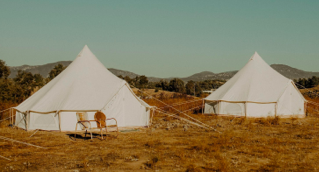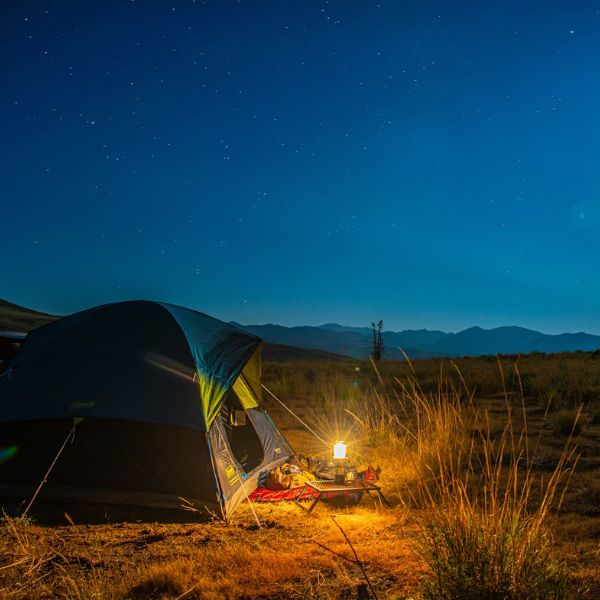FREE SHIPPING
PAY NO SALES TAX
Menu
-
- Shop
- Glamping Tents
- Wall Tents
- Canvas Tent
- Bell Tents
- Festival Tents
- Hunting Tents
- Yurt Tents
- Family Tents
- Stargazing Tent
- Cabin Tents
- Camping Gifts
- Overland Tents
- Tent Stoves
- 4 Person Tents
- 6 Person Tents
- 8 Person Tents
- 12 Person Tents
- Canvas Bags
- Camp Gears
- Camping Chairs
- Shade Canopy Tents
- Camping Fans
- Resources
- About
- Contact Us
- Reviews
-
- Login

Free Shipping

Pay No Sales Tax
30-Month Warranty
FREE SHIPPING
PAY NO SALES TAX
Tents
Shop


The LiT List
Glamping & Camping Ideas + Resources
Well Seasoned: Tips on Storing Firewood Outside
5 min read
Since the best time to stock up on firewood cords is late summer to early fall, now’s the time to grab your wood carrier and master the art of outdoor firewood storage.
What’s so important about your outdoor firewood storage? One word: moisture.
Knowing how to properly store your firewood logs to ensure they stay dry, seasoned, and ready to burn is important to keep those flames ignited and hot. So help your wood stove run efficiently and keep your tent or home toasty with these tips on storing firewood outside to ensure it’s well-seasoned and ready to go this winter.
Tips on Storing Firewood Outside
Firewood burns most efficiently when it is good and dry. It also ignites easier (read: no fanning flames all night to keep the embers lit) and creates minimal smoke (from water moisture, mold, and rot), and creosote that can build up in your wood stove chimney. To make those logs good and dry, follow these firewood storage tips.
Lift Firewood Off the Ground
Tent footprints and tent platforms can block ground moisture from getting through, helping to prevent condensation inside your tent. This ground moisture is the same reason you should avoid setting firewood directly on the earth, mud, grass, etc. Essentially, firewood sucks moisture from the ground. Worst case scenario, your firewood rots, attract insects and other pests, and isn’t efficient to burn. So, ideally, your firewood stack should be raised above the ground.
Here are some raising methods we suggest:
If you keep a main woodpile at home, an elevated firewood holder like a ring or rack makes a really attractive choice, but it could be as simple and primitive as a pallet.
Taking a bundle of firewood camping? Without a dedicated firewood ring, you have a few options. You can lift it using spare 2” x 4” boards or place the stack on a concrete pad or asphalt road around the site. At the very least, know you’ll need to sacrifice the bottom row of wood (and let it dry out last).
Lastly, wherever you elevate your firewood, make sure it’s flat, flush, and stable.
Stack Firewood Logs in Alternate Directions
As you prevent ground moisture from below, you must allow airflow within the stack. Airflow ensures your wood pile keeps dry. The best way to encourage airflow is to create air pockets by alternating and turning the logs as you stack them. At the very least, stack the logs loosely.
Important Tip: When stacking your firewood, avoid stacking too high. A high pile of firewood, even if balanced and neatly stacked, has the potential to fall and become dangerous. Aim for a stacked height of 4 feet, maybe 5 feet tops when you’re using a firewood rack that provides a sturdier frame.

David Cole | Unsplash
Cover Your Firewood Stack
Again, airflow is key. So keep a waterproof cover over your woodpile to combat rain and snow.
However, one precaution to take with a firewood cover is to not seal it too tightly against the wood. You’re not creating a pile of mulch or compost. Instead, keep the sides open and give it a small air pocket up top (another reason a firewood rack with a cover performs well!)
You can find firewood covers made from nylon or vinyl tarps and breathable canvas. If you enjoy the idea of a firewood rack outside the home, keep an eye out for custom-fit cover variations with zippers that allow you to swiftly reach the logs inside.
Another option to protect your firewood is to store it in a shed.
If you’re camping, a tarp will cover your firewood perfectly well.

Jon Tyson | Unsplash
Store Firewood Outside, But Close to Home
Pick a location for your firewood pile that is close (but not too close!) to your home. When your firewood stack is nearby, it’s more convenient to retrieve when you need to build a fire. However, you should avoid keeping wood stacked close or even directly against the house, as this can attract unwanted pests – like termites, rodents, and snakes – closer to the building structure.
Instead, consider keeping a smaller firewood rack inside the home. A rack that allows you to store a bundle or two of firewood for a night. That way, when it’s raining or snowing, you can load up your canvas wood carrier and stack it inside.
Tip: This also helps thaw firewood so it can ignite more easily and burn more efficiently.
Store the Firewood Stack for Sun Exposure
As you consider where along your property to store your firewood outside, remember: the sun is your friend. Plan to keep firewood located somewhere along the south or west location where it’s able to receive the most sun exposure.
The same applies to your campsite. Keep your firewood bundles on the southern-facing section of your site to let the sun bake the wood as much as possible.
Of course, if your southern or western direction is shaded by trees or whatever else, it might not be the best scenario. But the point is to allow sunlight to dry out the wood and prevent moisture.
Rotate Your Seasoned Firewood
Buying another cord of wood this season? Make sure to rotate your firewood stack so that the oldest, most seasoned wood is accessible. You want to burn the driest wood first and leave the greener wood to dry out longer. This is commonly called the “first-in, first-out” rule.
Some firewood racks will offer covers that unzip along the side or center, making it easy to grab logs off the bottom. So use whatever rotational method makes sense for your setup.
Must-Know Facts on Seasoned Firewood

Hans Isaacson | Unsplash
Before you even stack your firewood, make sure it’s dry. Fresh, newly-cut firewood still requires time to season, so make sure the green wood is exposed to the sun and air.
Firewood that is seasoned properly will burn hotter and more efficiently, offering minimal smoke, if any. It also reduces creosote buildup inside the flue of your chimney or wood stove, which can cause a fire hazard if not routinely cleaned and maintained.
Signs of Well-Seasoned Firewood
- Visual Tell-Tale Signs: Seasoned firewood will appear gray or darker, splitting as it dries and shrinks. The bark will also be looser, maybe even falling off. Green wood might even smell fresh or look damp.
- The Knock Test: Knock together two pieces of wood and listen. What do you hear? If it’s hollow-sounding, your wood is seasoned. (Due to moisture content, unseasoned green wood makes a dull thud.)
- Measuring for Moisture Content: A moisture meter device can tell you precisely how much moisture is still inside the firewood simply by inserting prongs into the log. (The meter should read no more than 20%.)
- Weight: Seasoned firewood should be lighter. (Again, less moisture content means less water weight.)
How Long to Season Firewood
Fresh-cut wood needs approximately 6-18 months to season. This depends primarily on the type of wood (hardwood vs. softwood) as well as weather conditions in your region.
If you want to hasten the drying process, split the logs into smaller pieces.

Clay Banks | Unsplash
A Note About Transporting Firewood
Firewood is a nice addition to making camp bonfires and a necessity for many. However, transporting firewood long distances comes with its own set of problems. Non-native species, pests, and diseases, from insects to fungi, can become invasive and harm your local ecosystem. So it’s important to keep this in mind when choosing and transporting firewood.
When gathering logs or buying cords, know where the wood came from. A good rule of thumb is to find firewood within 10-50 miles from where you store or burn it. If you go camping further out, and not where the wood originated from, consider picking up firewood closer to the campsite. It’s safer and cleaner for the environment.
SHOP OUR FIRE GEAR
Leave a comment
Comments will be approved before showing up.
Related Resources

THE LIT LIST 5 min read
Top 10 Features to Look for in a Camping Lantern
An essential piece of gear for any outdoor enthusiast is a camping lantern. Whether setting up camp,In search of the perfect camping lantern? Here are some top features to look for, from rechargeable battery and solar to dimmable LED brightness settings and more.

THE LIT LIST 7 min read
The LIT Guide to Camping Tent Accessories
The right accessories for camping tents can turn a simple shelter into a cozy, well-equipped retreatElevate your outdoor experience with the right camping tent accessories.
Popular Blogs
Camping Gift Ideas for People Who Have Everything
The Best Portable Tent Heaters - Ways To Heat A Canvas Tent
Glamping in Northern California: 8 Luxury Sites
Waterproofing A Canvas Tent - Retreating Canvas
33 Camping Quotes to Inspire Your Next Adventure
What Is Glamping? Origins, Definition, Destinations & More
10 Tips for Staying Warm While Winter Camping
How to Maintain and Clean a Bell Tent
Essential Family Camping Checklist: What to Pack [PRINTABLE]
Backyard Glamping Checklist for an Unforgettable DIY Glampsite
Popular Products
Subscribe
Sign up to get the latest on sales, new releases and tips
BECOME AN INSIDER
We’ll periodically share inspiration, bell tent releases, special offers, and event notifications with ya.


